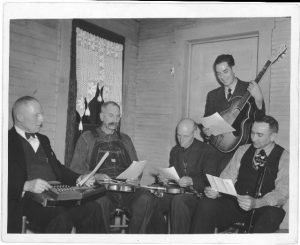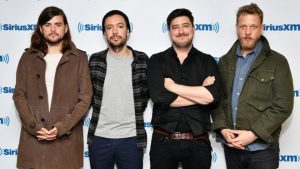Growing up, I had a specific image of a banjo player in my mind. I imagined a white male wearing overalls sitting on the front porch of a white house with a white picket fence surrounded by farmland.
Now, I recognize how close this picture is to an idea of the American Dream, a hope often associated with, home ownership, comfortable living, wealth, opportunity, and fame. While the image of the “white picket fence” is more of a romanticized image often situated in Hollywood, it does represent a core tenant of the American Dream—success.
But, how come my image of a banjo growing up was so aligned with a version of the American Dream?
To further consider the banjo’s symbolism in the American Dream, specifically the image and idealized version of this dream, I searched simply “banjo” in the Library of Congress Prints and Photographs: Lomax Collection, and eight photographs appeared from the search. Each photo contained either an individual playing the banjo, or a group of musicians, one of which is playing a banjo.
Two crucial traits were consistent throughout all the images: white and male.
One, for example, is an image from 1937 of the Bog Trotters Band, where one of the players is on the banjo (below). They are looking at sheet music in a house with lace curtains, wearing a variety of clothing from overalls to a suit, playing instruments in good condition. While subtle, the three factors of well-taken care of instruments, nice clothing, and delicate lace curtains represent, to me, success, crucial to the American Dream. It appears as though these men are living out their American dream, using the banjo as a stepping-stone to their success [1]. The Bog Trotters Band was such a staple of bluegrass that there is now a new band in the 21st century, the Galax Bogtrotters, who found their music so inspiring they decided to use their name.
From this image, and what I found by searching “banjo,” it appears as though I’m not alone in categorizing the banjo with a romanticized ideal of the American Dream and with, to be frank, whiteness. Neil Rosenberg in his “Introduction” from Bluegrass: A History shares a common perception of the history of the banjo. While the following quote doesn’t address the banjo explicitly, it discusses the popular ideas of when bluegrass began, and the banjo is a crucial aspect of bluegrass.
It seems imbedded in the history of the bluegrass genre, and Rosenberg questions if bluegrass began in 1939 with Bill Monroe and his Blue Grass Boys or in 1945-48 when Lester Flatt and Earl Scruggs were performing with Bill Monroe. All white men [2].
However, Rhiannon Giddens in her Keynote speech at the 2017 International Bluegrass Music Association Conference would argue that bluegrass began much earlier, as she defines bluegrass as complex Creole music coming from African, European, and Native American roots. She adds that the banjo used to be a symbol of African American expression, as it started as a plantation instrument, but it has done a 180 [3]. She evaluates how the banjo and bluegrass has become known as a white art form, but it rather began with roots in slavery.
Fast forward to the now. There are still popular bands that feature banjo playing, such as Mumford and Sons. As you can see in the picture above, these men all still identify as white. In a way, they are continuing the same image that the Bog Trotters Band did: white men living out the American Dream of fame and success, but ignoring an entire race who contributed to the evolution of the banjo and bluegrass.
Bibliography:
[1] Bog Trotters Band members seated with instruments. 1937. Library of Congress Prints and Photographs: Lomax Collection, Washington D.C., USA.
[2] Rosenberg, Neil. Bluegrass: A History. PDF file. https://drive.google.com/file/d/0BxQzWOgr8AureDRQbF9UMGwyU2VCNzRXTWI4SFduMFFPMUo4/view
[3] Giddens, Rhiannon. “Rhiannon Giddens Keynote Address.” Paper presented at the IBMA Business Conference, Raleigh, NC, September 2017.


